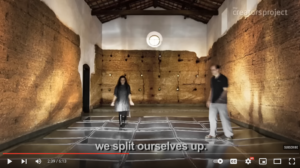MATERIAL ANALYSIS
-
Water:
- Characteristics: Reflective, dynamic, fluid.
- Visual Impact: Projections on water surfaces will ripple and distort, creating an ever-changing and ephemeral effect. Reflections add depth and complexity to the visuals, enhancing the overall immersive experience.
- Sound Correspondence: Water sounds such as gentle waves or splashing add an auditory dimension to the installation, enhancing the sensory experience.
-
Stone:
- Characteristics: Solid, textured, rough.
- Visual Impact: Projections on stone surfaces will retain texture and may appear slightly muted or subdued. The roughness of the surface adds a tactile quality to the visuals, creating a sense of groundedness and solidity.
- Sound Correspondence: Stone surfaces may evoke sounds of echoes or reverberations, enhancing the overall auditory ambiance.
-
Trees:
- Characteristics: Organic, textured, irregular.
- Visual Impact: Projections on tree surfaces will interact with leaves, branches, and natural contours, creating a layered and immersive effect. The irregularity of tree surfaces adds depth and complexity to the visuals, blurring the boundaries between nature and artifice.
- Sound Correspondence: Tree surfaces may evoke sounds of rustling leaves or creaking branches, enhancing the naturalistic ambiance of the installation.
-
Curtains:
- Characteristics: Soft, flexible, semi-transparent.
- Visual Impact: Projections on curtain surfaces will appear diffuse and ethereal, with images subtly shifting and changing as the fabric moves. The semi-transparency of curtains adds a sense of mystery and intimacy to the visuals, inviting audiences to peer through layers of fabric.
- Sound Correspondence: Curtains may evoke sounds of gentle rustling or swishing, enhancing the atmospheric quality of the installation.
-
Mirror:
- Characteristics: Reflective, smooth, polished.
- Visual Impact: Projections on mirror surfaces will be mirrored back to the audience, creating a sense of infinity and doubling the visual impact. The smoothness and polish of mirror surfaces enhance clarity and sharpness, allowing for precise and detailed projections.
- Sound Correspondence: Mirror surfaces may amplify sounds, adding a sense of resonance and depth to the auditory experience.
Projecting an Image onto Water, Windows, and Other Challenging Surfaces – GoboSource
RESEARCH
-
MEANS OF PROJECTION
Based on Ming’s idea for creating four dimensions, we came across a project called Cube Infinite. They used six mirror surfaces, which were put together into a cube shape. They explained that when they looked into it through an opening, it gave a vertigo-like sensation. This made me curious if a four-dimension feel could be achieved when the projection is made inside this cube which would feel like an infinity realm inside scanned buildings or created with scanned images of outside places.

When Infinity Comes To Life (youtube.com)
This gave an idea of how different materials come together in the same place and give us different visual experiences. In this project, they use a specific kind of mirror that makes things appear concave when come closer and convex as you go further. At an optimum distance, it appears to be flat. How could this surface change the visual experience if the scanned projections are onto them?
This gave rise to another thought about surfaces that interact with human movement or touch. Exploring not only the movement but also enhancing it with projections and sounds that correspond would be something interesting to work on.
-
Ryoji Ikeda’s audiovisual in Amos Rex museum
The art of Japanese composer and artist Ryoji Ikeda (1966) consists of precise soundscapes and moving image. The artist approaches his materials in the manner of a composer. Whether a pixel, sound wave, space or data, Ikeda sees them all as part of the composition process.
Ikeda’s exhibition at Amos Rex draws inspiration from the museum’s extraordinary architecture. On view are five installations, which explore the invisible dimensions of the universe and pushes the limits of perception.
Data Translation : The work translates various data inputs into audio-visual outputs that reorder how we see and hear the world around us. This speaks to Ikeda’s broader artistic aim of revealing the hidden structures and patterns that underlie our reality.
Immersive environment: The 2,200 square meter domed underground space, combined with surround sound and large-scale projections, creates an immersive experience that envelops the audience. The industrial hum and vibrations add to this effect.
Hypnotic, meditative visuals: Works like “mass” feature repetitive, pulsing geometric animations that have a hypnotic, trance-like quality. They act as visual mantras that captivate attention and inspire imagination.
Perceptual phenomena: Many of the works leverage illusory effects, afterimages, and optical tricks to engage the viewer’s perception. For example, “spin” uses a rotating laser projection to create a flickering 3D/2D effect.

Ryoji Ikeda adds to his universe of data in Helsinki – The Japan Times

